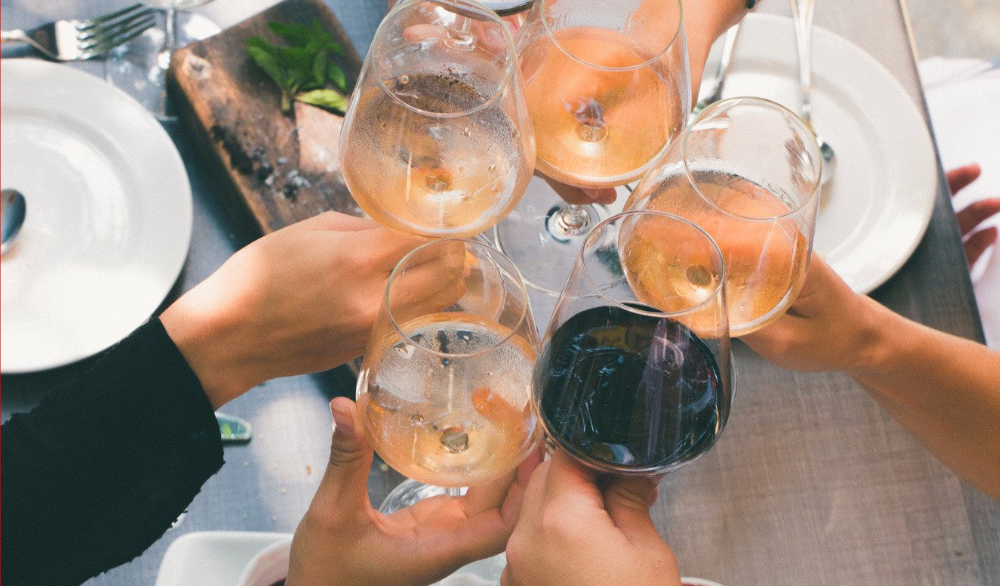Congratulations!
You started out on your fat loss journey and you have FINALLY seen some progress.
Let’s celebrate!
With what?
A drink of course!
Alcohol started as a drink for celebrations, gatherings, and ceremonies. While it’s still used for all of those, it’s become such a social drink, it’s rare to find and event or gathering without it.
Alcohol is more than likely involved in a part of your lifestyle.
For quite a while, it was believed that alcohol and fat loss CANNOT mix. The general
belief was that you could not have the lean body of your dream while sipping on some beer or wine.
Thankfully, more and more research comes out on the concept of flexible dieting and the idea of balancing nutrient dense food with some of your guilty pleasures.
Do you know what the research says?
Alcohol won’t make you fat or send that lean muscle up in flames…
IF you consume it properly.
As you go through and read this blog, know that I’m NOT telling you to work out and use alcohol as your post workout drink of choice. That WILL make you fat. Please take a careful read through this information so you don’t take things out of context and regret
things later.
Let’s get into this.
What Is Alcohol?
The best way to know how to incorporate alcohol into your life is to truly understand what it is, its properties, and how it interacts with your bodily systems.
Chemically, alcohol is made up of the chemical compound ethanol. The ingestion of alcohol sparks a chemical reaction, wherein a percentage of the ethanol that is consumed immediately burns up. Research estimates that 80 percent of the alcohol ingested is absorbed into the body, and 20 percent is burned up via thermogenesis.
Do you ever wonder why your face gets red and your whole body seems to heat up
while drinking?
That’s the ethanol burning up within your body and your body’s attempt to emit the heat.
Now, just because ethanol burns up inside your body doesn’t mean you can drink all you want without worry.
You know that’s not true.
Think about what the other 80 percent does to your body. It affects nearly every bodily system.
Central Nervous System:
- Changes behavior
- Inhibits speech and coordination
- Lowers inhibition and impulse control.
Digestive System
- Makes it difficult to absorb nutrients
- Limits our intestines ability to control bacteria
- Triggers acid reflux and heartburn
Circulatory System
- Long-term use related to irregular heartbeat, high blood pressure
- Increased risk of stroke and heart attack.
Reproductive System
- Increased likelihood for erectile dysfunction
- Negatively influences hormone production and secretion
Skeletal System
- Inhibits new bone production
- Increased likelihood for muscle weakness, cramping, and atrophy
Immune System
- Slows its ability to produce white blood cells as well as current WBC efficiency
- Increased likelihood to succumb to illness
What Is Alcohol Nutritionally?
One of the most common questions I get when it comes to alcohol is “What do I count it as?”
Clients wonder whether to regard it as a protein, carb, or fat all the time.
The truth?
Alcohol is it’s own macronutrient. It’s heavily debated as beneficial because of it’s ability, or lack thereof, to beneficially provide energy to the body.
Here’s the macronutrient breakdown:
- Protein – 4 Calories per 1 Gram
- Carbs – 4 Calories per 1 Gram
- Fat – 9 Calories per 1 Gram
- Alcohol – 7 Calories per 1 Gram
As you can see, alcohol contains more calories per gram than carbs, yet most people regard alcohol as a sugar or carb when it comes to tracking.
Not true.
Alcohol and carbs are processed VERY differently inside the body, so it’s important to regard it as its own macronutrient.
Knowing and understanding the differences between alcohol and the other macronutrients is important when working it into your dietary budget.
Even if you’re drinking certain alcohols straight because of it’s a more calorically dense macronutrient, some sugary non-alcoholic drinks may be better caloric alternatives.
If you’re preparing to consume alcohol, a flexible approach is KEY for long-term success.
Let’s say you’re planning to go out for a few drinks with friends on a Friday night. The best solution for remaining on track is to cut some carbs and fats (never protein!) from earlier in the day to make room for the calories from alcohol.
It’s the same as if you were planning a cheat meal!
What if it’s too late, something came up, and I cannot cut any carbs or fats?
Then we shift our focus to our WEEKLY total caloric and macronutrient intake. The plan then goes to cutting some carbs and fats the following day to ensure your weekly intake remains in check and your results do not suffer.
Now, this strategy does give us the freedom to eat or drink what we want while maintaining positive body composition changes; however, altering your macronutrient intake too frequently can definitely cause your results to suffer.
For my clients, I recommend enough flexibility to better long-term adherence and alleviate psychological stress, but not too much to hurt results.
How Does Alcohol Influence Body Composition?
Now we get to some of your most burning questions:
Is alcohol easily stored as fat?
Can alcohol hurt fat loss?
Does alcohol make me lose muscle?
The simplest answer?
Yes.
If you’re not controlling your alcoholic intake, your progress related to muscle building and fat loss will absolutely suffer.
So what’s defined as a controlled intake?
Well, a few drinks either in a night or across the week will have little to no effect on fat loss or muscle building IF your overall caloric intake is within the appropriate range.
Where we run into problems is upon entering the 4+ drink range. Once you consume 4 or more drinks, the alcohol can significantly slow down muscle protein synthesis (which slows your recovery process sand muscle tissue rebuild) and lipolysis (the breakdown of fats).
The good news, this hinderance is only temporary.
If you consume enough alcohol to get drunk, your body is unable to efficiently produce muscle and burn fat. Once alcohol has left your body, these processes resume and you’re once again on track with your body composition goals.
But it’s not just the muscle protein synthesis and fat oxidation that’s influenced by alcohol…
Research suggests alcohol effects both testosterone and female functioning hormones.
Over consumption of alcohol has been shown to lower testosterone levels. Where it gets tricky is when there is also research that suggests that the mild consumption of alcohol raises testosterone levels; however, these are not regarded as such significant raises that muscle growth is dramatically increased.
When it comes to female hormones, there’s much less research, but what is out there suggests alcohol mildly impairs female hormones.
Where alcohol is most damaging is its ability to lower your inhibitions. We all know about and maybe have done some stupid things after a few drinks, so it’s not worth going through the research surrounding alcohol’s correlation to poor decision making.
By itself, alcohol is an incredibly unsatiating nutrient, but add to the fact that you’re more likely to make poor decisions after consumption, you’re MUCH more likely to consume lower quality foods while under the influence.
That fact is the primary reason you struggle to lose weight while consuming alcohol.
Drinking alcohol and eating together lowers your self-discipline and too often puts you in a caloric surplus to see true body composition results.
How Do I Fit It In?
Let’s summarize what we know about alcohol.
- Alcohol is an unsatiating nutrient.
- Alcohol stores more calories than carbs, but slightly less than fats.
- Alcohol burns up quickly upon consumption.
- Alcohol lowers your inhibitions and abilities to make good decisions.
- Alcohol and its related decisions put you into a caloric surplus.
- Alcohol negatively impacts your ability to burn fat and build muscle.
None of that sounds GREAT, but from the information above, you also know that if you periodically fit it into your caloric intake, you won’t completely limit your results.
The only question left to answer is where do you fit it in to cause the least amount of damage?
My recommendation for my clients is to take out either carbs and fats and substitute it for alcohol.
If you’re like most people, carbs and fats are the foods you enjoy most, so you’re probably wondering why you have to cut out those and not protein?
Well, if you want to really dive into the benefits of protein, head over to The Protein
Guide for Fat Loss to get the full scoop.
For now, here’s a summary:
- Protein has a higher Thermic Effect of Food (TEF – meaning you literally burn more just by eating it).
- Protein is the most satiating nutrient (perfect to compliment the least satiating nutrient, alcohol).
- Protein is the nutrient least likely to store as body fat.
- It’s very difficult to consume junk protein.
You get the point, protein is important, but how do you decide whether or not to cut out carbs or fats?
If you’re a lightweight and want to limit how intoxicated you get, keep the carbs in your day and cut the fats. The carbs help to absorb the alcohol and slow its effect on your body.
If you’re not a lightweight or you’re looking for best results, I personally recommend cutting down on fats. Fats contain the most calories per gram, which means cutting them out leaves more calories for you to work with throughout the night. Carbs are also more filling to most people and less likely to be used for fat storage because of its need as a fuel source.
Not sure which one to cut?
Split the difference and take some from both.
Remember, it’s all about caloric balance, meaning you can flex your intake to your preferences and still be successful.
If you’re someone who doesn’t track calories or macros, the best recommendation I have for you is to plan on eating ONLY lean proteins and veggies throughout the day. If it’s a training day, you should consider adding a starchy carb like white rice or sweet potatoes around your training time.
This strategy leaves you with plenty of calories for dinner and drinks, and it also fills you up on protein and a variety of micronutrients.
When it comes down to it, alcohol is a part of life, so restricting it isn’t going to improve your long-term adherence (the key to sustainable results). There aren’t many things or situations where overdoing it is beneficial for your body composition or health. Be moderate in your intake, track your calories and macros, and enjoy your drinks and time with others.
About The Author

Jordan Davies is the Co-Owner of Complete Performance. Jordan has her B.S. in Exercise Science and Psychology, and her M.A. in Holistic Health Studies. She is a CSCS certified strength and conditioning coach, and a PN-1 and NCI-1 certified nutrition coach. She loves to study how the human body needs to be moved and nourished and making that fit to your unique lifestyle. Click Here Now to Apply for Coaching with Jordan.





